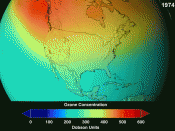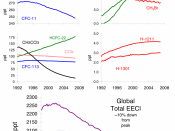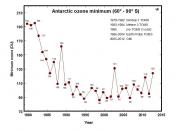Protecting the Ozone � PAGE �1�
Protecting the Ozone Layer That Protects Life on Earth
University of Phoenix
Introduction to Life Sciences
Word Count: 4,583
�
Protecting the Ozone Layer That Protects Life on Earth
Over the past few decades, researchers worldwide have been concerned about the gradual depletion of the ozone layer, which is the atmospheric layer in the stratosphere miles above the Earth that protects all life forms from harmful ultraviolet rays emitted from the sun. The ozone layer is necessary to protect life on Earth from overexposure to deadly sun radiation that could lead to skin cancer, eye cataracts, sunburn, premature aging, and other health concerns. Depletion of the ozone may also contribute to global warming, which may have widespread dangerous environmental affects on the Earth's climate. Ozone depletion is a serious issue brought about by mankind's abuse through industrialization, and only mankind can act and take necessary steps to undo the damage and restore this vital protective layer, without which life could not exist on Earth.
According to NASA, ground based measurements of ozone began in Antarctica in 1956, and satellite measurements started during the 1970s. In 1978, the Nimbus-7 satellite initiated the first worldwide measurements. Today, there are several satellites that monitor the Earth's atmosphere (Sparling, 2001).
What Causes Ozone Depletion?
The primary cause of the depletion of the ozone layer is chlorofluorocarbons (CFCs). CFCs were first created in 1928, and Dupont became the first company to manufacture them for commercial use during the 1930s. Since that time, CFCs have been produced worldwide with consumption reaching its peak during the 1980s (Sparling, 2001). Various types of CFC, a single carbon combined with two chlorines and two fluorines, are used in refrigeration, air conditioning, cleaning solvents, and aerosol sprays (World Almanac Education Group, 2005).


